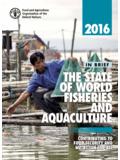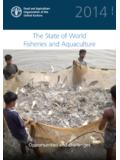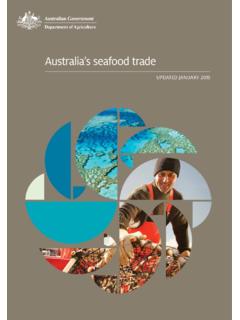Transcription of Toward Sustainable Management of World …
1 07/07/2006 04:45 PM Page 1. 15. Toward Sustainable Management of World fisheries and Aquaculture KIERAN KELLEHER AND MICHAEL L. WEBER. T he continuing depletion of the World 's marine fisheries is a key indica- tor of a critical decline in ocean health and a global issue of increasing concern. Fish is an important food for billions of people and provides a liveli- hood for an estimated 200 million people worldwide. The living marine resources of the planet are also an important part of the Earth's diversity of life, providing a range of ecological services and support recreation, scientific research, and tourism. Yet in the last half century the growth of human pop- ulations and economies, the spread of new technologies such as fishing nets made from synthetic materials, and the motorization of fishing fleets have contributed to the decline of many fisheries , jeopardizing ecological and eco- nomic sustainability for coastal communities around the World .
2 The task of making fisheries Sustainable has local, regional, and global dimensions. Fish and fishers move from sheltered bays and estuaries to the open ocean, and from one ocean to another. Small-scale fishers from Senegal and Ghana fish in the waters of many other countries in West Africa and in the Gulf of Guinea; European and Asian industrial tuna fleets operate throughout the Atlantic, Indian, and Pacific Oceans. The rapid expansion in the global fish trade means that fish products from even the most remote fish- eries are gradually entering World trade. The depletion of fish stocks and loss of critical marine habitats due to overfishing can be traced to the inherent nature of wild fisheries as a com- mon property to which all have access (see figure ).
3 For example, in 1. 07/07/2006 04:45 PM Page 2. 2 Global Issues for Global Citizens FIGURE Growth of an Ungoverned Open Access Fishery Catch/value of catch Effort/cost of effort Overexploited fishery Low catch per boat Unstable stock structure Few large fish in catch Heavily exploited fishery Negative financial returns for Decreasing catch per boat some fishermen/boats Average size of fish decreasing Investment switching to Increasing investment in gear marketing, processing and Developing fishery Increase in size of boats 2nd-hand vessels Catch Stable catch per boat Decreasing net returns Increasing political pressures/. Average size of fish constant Harvesting immature fish conflicts from interest groups Catch value Increasing number of boats Shoreside over-capacity Entrepreneurial financing Cost of catch New fishery Maximum difference between value Virgin fish stocks of catch and cost of effort (~ profit).
4 High catch per boat Large average size of fish Small number of boats Effort level for Maximum Effort level for Maximum Economic Yield (MEY) Sustainable Yield (MSY). Fishing effort and/or number of vessels Source: Kelleher (1996). many small-scale fisheries there are no restrictions on who may fish; as a result, a growing number of fishers, having few alternative economic options available, compete for limited fish resources. Since individual fishers have no incentive to restrict their fishing so as to preserve the common resource, an effective form of governance is needed, either to provide such an incentive, or to enforce restrictions to ensure the Sustainable use of the resource. The problem is the same at the international level.
5 Nations may act like individual fishers, each seeking its own individual benefit. Thus, without effective international regulation, fisheries accessible to more than one coun- try, including those on the high seas, may suffer this tragedy of the com- mons. Yet efforts to provide such regulation have been beset with problems. Many existing international instruments designed to regulate high-seas and transboundary fishing are weak. Subsidized international fisheries access agreements may benefit fishers from industrial countries at the expense of fishers from developing countries. Regional fisheries man- agement organizations have limited powers of enforcement, and their 07/07/2006 04:45 PM Page 3. Toward Sustainable Management of World fisheries and Aquaculture 3.
6 Consensus decisions often reflect an ineffective compromise at the lowest common denominator. The existing Law of the Sea Convention and its sub- sidiary instruments have important gaps, and effective enforcement of mea- sures for responsible high seas fishing has proved elusive. Vessels flying flags of convenience transgress national and international law with impunity, and subsidies provide inequitable support to maintain overcapacity in industrial fleets. At the heart of the matter lies a lack of political commitment to resolve a difficult problem, one that requires long-term national, regional, and inter- national efforts to build awareness and consensus. The short-term political costs of fisheries reform may be high, yet the techniques and applications required to reduce risks and secure the potential long-term benefits often require investment and testing as well as sensitivity to the social costs of change.
7 The Global Importance of fisheries For some billion people around the World , fish provides at least 20 per- cent of average per capita intake of animal protein. Fish is a particularly important part of the diet in developing countries, where total protein intake level may be low. In Bangladesh, Cambodia, the Republic of Congo, Equatorial Guinea, and Sri Lanka, and in some small island states, fish may account for 50 percent of total animal protein. (For comparison, the average share in industrial countries is only 8 percent.) Declines in fishery resources caused by overfishing or a significant increase in the price of food fish can thus seriously affect the nutritional status of major population groups. In 2002 about 76 percent of estimated World fish production was used for direct human consumption; much of the remainder was used in the manufacture of fishmeal and oil.
8 These products are generally manufactured from small pelagic fish (fish that live in surface waters). These species, such as anchovies and sardines, made up 37 percent of total marine catches in 2002. Worldwide, 38 million people are full-time fishers or fish farmers, and fish- ing, aquaculture, and related activities such as fish processing employ roughly 150 million people in developing countries. The Food and Agriculture Orga- nization of the United Nations (FAO) estimates that, since 1990, the number of full-time fishers has been growing at an average rate of 21 2 percent a year;. the total increase since 1950 is about 400 percent. Most of this growth has been in small-scale fisheries in the developing World , particularly Africa and 07/07/2006 04:45 PM Page 4.
9 4 Global Issues for Global Citizens Asia, where poverty among coastal communities is often high and fishing is often the livelihood of last resort. In 2004 the global fishing fleet comprised roughly million decked fishing vessels and million open, or undecked, fishing vessels, of which 65 percent were without engines. Trends The FAO, which monitors trends in the World 's fisheries , reports that total World production of fish products by freshwater and marine fisheries and by aquaculture increased steadily from 19 million metric tons in 1950 to 100 million tons in 1989 and nearly 140 million tons in 2004 (figure ). Since 1985, developing countries have accounted for more than half of this production. Marine fisheries catches increased to about 80 million tons by the end of the 1980s and have since then remained at about that level, accounting for about 60 percent of global production in 2003.
10 However, the relatively sta- ble level of catches in recent years obscures some problematic changes in the World 's fisheries . In many areas, catch levels have been maintained only through increasing effort and investment in more and better-equipped FIGURE Production from Capture fisheries and Aquaculture by Developed and Developing countries, and Food Fish Supply per Capita, 1972 2004a Millions of metric tons Kilograms per year 160 17. Total production, developing countries 140 Total production, developed countries 16. Capture production 120 Aquaculture production Food fish supply per capita (right scale) 15. 100. 14. 80. 13. 60. 12. 40. 20 11. 0 10. 1972 1976 1980 1984 1988 1992 1996 2000 2004. a. Excludes aquatic plants.

















